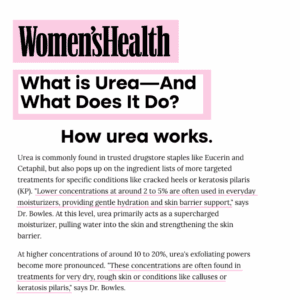What is Urea? | As Seen in Women’s Health
Urea is a powerful yet gentle ingredient that plays a crucial role in skin hydration and renewal. Dr. Alexandra Bowles breaks down this ingredient and explains how to use it in Women’s Health’s article.

What is urea?
It’s a naturally occurring compound found in the skin and is a key component of the skin’s natural moisturizing factor (NMF). It’s a powerful humectant, which means it attracts moisture to the skin, helping to keep it hydrated and soft. I find it especially effective in skin care because it’s not only moisturizing but also helps to maintain the skin’s overall health.
How does urea work in skincare?
I think of it as working in two main ways in skin care: as a moisturizer and a mild exfoliator. As a moisturizer, urea draws water into the skin, helping to keep it hydrated and smooth. It also supports the skin’s barrier function, which is essential for maintaining overall skin health. Urea gently breaks down the bonds between dead skin cells, helping to slough them off and reveal smoother skin. I’ve seen it work really well for dry or rough skin, as it both hydrates and gently resurfaces. Additionally, it has soothing properties that can help with skin conditions like eczema and psoriasis.

Does concentration of urea matter? What should you look for?
Yes, the concentration does matter. Higher concentrations (around 10-20%) are typically used for more intense moisturizing and exfoliation. This is often found in treatments for very dry, rough skin or conditions like calluses or keratosis pilaris. Skincare products often include lower concentrations of urea (around 2–5%) to provide gentle hydration and support the skin barrier in everyday use. If you’re new to urea or have sensitive skin, I suggest starting with a lower concentration and gradually working your way up if needed. Always check the product’s instructions for how often and how much to use, especially if you’re trying a higher concentration.
Can urea be used with other skin care ingredients?
Urea is generally compatible with a wide range of other skin care ingredients, such as hyaluronic acid, ceramides, and peptides. However, I would recommend being cautious when combining with stronger exfoliants like alpha hydroxy acids (AHAs) or retinoids, as this could lead to irritation, especially for sensitive skin. If you’re using a product with a higher concentration of urea, it’s a good idea to start slowly and see how your skin responds, particularly if you’re already using other active ingredients.
Is urea safe for all skin types?
Urea is safe for most skin types, but I find it’s particularly beneficial for people with dry, rough, or flaky skin. People often use it to treat skin conditions like eczema, psoriasis, and keratosis pilaris because it hydrates and gently exfoliates the skin. For those with oily or acne-prone skin, urea can still be helpful. I suggest choosing a product with a lower concentration to avoid potential clogging of pores. Those with very sensitive or compromised skin should use urea with caution. I recommend starting with a lower concentration or consulting with a dermatologist before incorporating it into their routine.
